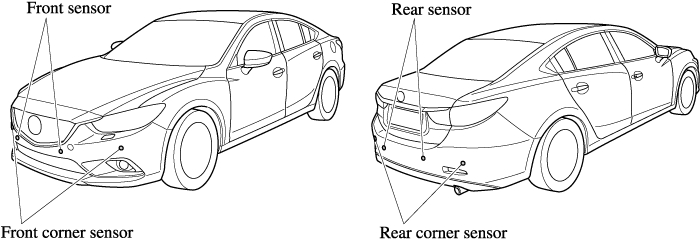Parking Sensor System (Some Models)
The parking sensor system uses ultrasonic sensors to detect obstructions around the vehicle while parking the vehicle in a garage or during parallel parking when the vehicle is driven at a speed of about 10 km/h (6 mph) or less. The system is equipped with an assist device to notify the driver of the approximate distance from the vehicle to the surrounding obstruction using a beep sound.

Do not rely completely on the parking sensor system and be sure to confirm the safety around your vehicle visually when driving.
This system can assist the driver in operating the vehicle in the forward and backward directions while parking. The detection ranges of the sensors are limited, therefore, driving the vehicle while relying only on the system may cause an accident. Always confirm the safety around your vehicle visually when driving.


-
Do not install any accessories within the detection ranges of the sensors. It may affect the system operation.
-
Depending on the type of obstruction and the surrounding conditions, the detection range of a sensor may narrow, or the sensors may not be able to detect obstructions.
-
The system may not operate normally under the following conditions:
-
Mud, ice, or snow is adhering to the sensor area (Returns to normal operation when removed).
-
The sensor area is frozen (Returns to normal operation when the ice is thawed).
-
The sensor is covered by a hand.
-
The sensor is excessively shocked.
-
The vehicle is excessively tilted.
-
Under extremely hot or cold weather conditions.
-
The vehicle is driven on bumps, inclines, gravel, or grass covered roads.
-
Anything which generates ultrasound is near the vehicle, such as another vehicle's horn, the engine sound of a motorcycle, the air brake sound of a large-sized vehicle, or another vehicle's sensors.
-
The vehicle is driven in heavy rain or in road conditions causing water-splash.
-
A commercially-available wing pole or an aerial for a radio transmitter is installed to the vehicle.
-
The vehicle is moving towards a tall or square curbstone.
-
An obstruction is too close to the sensor.
-
-
Obstructions under the bumper may not be detected. Obstructions that are lower than the bumper or thin which may have been initially detected but are no longer detected as the vehicle approaches more closely.
-
The following types of obstructions may not be detected:
-
Thin objects such as wire or rope
-
Things which absorb sonic waves easily such as cotton or snow
-
Angular shaped objects
-
Very tall objects, and those which are wide at the top
-
Small, short objects
-
-
Always have the system inspected at an expert repairer, we recommend an Authorised Mazda Repairer if any shock is applied to the bumpers, even in a minor accident. If the sensors are deviated, they cannot detect obstructions.
-
The system may have a malfunction if the beep does not operate or the indicator light does not illuminate when the park assist sensors switch is turned on. Consult an expert repairer, we recommend an Authorised Mazda Repairer.
-
The system may have a malfunction if the beep sound which indicates a system malfunction is heard and the indicator light flashes. Consult an expert repairer, we recommend an Authorised Mazda Repairer.
-
The beeper which indicates a system malfunction may not be heard if the ambient temperature is extremely cold, or mud, ice, or snow adheres to the sensor area. Remove any foreign material from the sensor area.
-
When installing a trailer hitch, consult an expert repairer, we recommend an Authorised Mazda Repairer.




 Read this first
Read this first



















